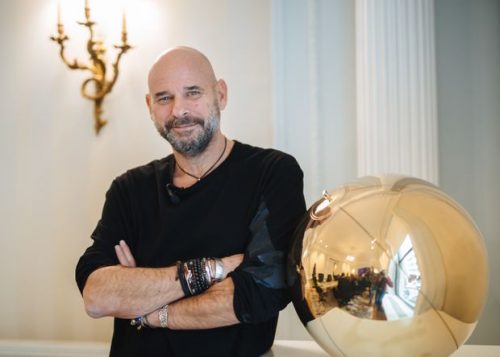Guy Laliberté has never been much for convention. The Cirque du Soleil founder chose a barren site next to a giant garbage dump for the company’s corporate headquarters and he likes to relax by playing high-stakes poker. Now, following a brief respite from business, he’s back with new plans that are as unexpected as ever.
Three years after cashing out of the Cirque in a $1.5-billion deal that saw the circus empire sold to Texas-based TPG Capital and China’s Fosun Capital Group, Mr. Laliberté is putting his capital to work in new ventures under holding company Lune Rouge. While some of them flow out of his knack for dazzling entertainment, others are a departure, proving that at the age of 59, the showman still has an appetite for risk.
“I’m going back into action as a creator and entrepreneur,” Mr. Laliberté said in an interview in late October, during which he gave a sneak peak of his plans in between drags on Gauloises cigarettes at Lune Rouge’s offices. “I always need a purpose.”
The flashiest project is scheduled to launch next June in Montreal’s old port. Dubbed PY1, it’s a new take on live performances, an art Mr. Laliberté has perfected over more than three decades. But instead of a big-top tent filled with acrobats, the enterprise centres on a seven-storey travelling pyramid where the show is avant-garde multimedia. Think lasers, 360-degree projections and atmospheric special effects.
The PY1 team has commissioned an initial production from a Montreal multi-disciplinary artist that it intends to take on tour. Presale tickets cost $30. The team wants to build a bank of such productions, eventually incorporating technology that will allow audiences on site to experience augmented reality. That means introducing digital elements on top of their actual physical environment, which they will be able to see with special glasses.
After the shows, the $15-million pyramid becomes a high-tech night club or concert venue with maximum room for 1,000 people. Mr. Laliberté said Lune Rouge is weighing partnerships with key developers working on technological interactivity, such as Plantation, Fla.-based Magic Leap Inc.
“The next year, 18 months is about proving my concept and show profitability,” Mr. Laliberté said. Then he’ll decide how to scale up operations.
Another project is called United Memory Archive (UMA), which is a business that allows people to document an individual’s life. There’s a secure website – a virtual vault – where you can build a digital profile of someone through audio, video, photos or text. The first two gigabytes of data are free. Anything more than that comes at a cost.
The company will also sell urns, which it calls “artefacts,” personalized with the information contained in the vault. Ranging in price from $200 to $20,000, they feature little or no digital technology because it will likely become obsolete over time (“Try and play a cassette tape now,” Mr. Laliberté says. “It’s problematic.”) Rather, the artifacts feature durable elements such as metal tablets containing engraved text. UMA has a partnership with the creators of the Rosetta disk, a three-inch-wide nickel disk with nearly 14,000 pages of information microscopically etched onto its surface.
“Over time, the passing of an individual has become something tremendously uncomfortable for our society,” said Lune Rouge executive François Plamondon. “We’re saying ‘No, we have to approach it in a different way and think of it more as a river of life, of continuity, of memory.’ ”
Lune Rouge’s nerve centre is the Maison Alcan, a downtown complex made up of seven buildings in Montreal’s Golden Square Mile district, which it bought in 2016 for about $50-million. The site is a mix of architectural styles, much of it protected with heritage status by the Quebec government.
Mr. Laliberté has already restored one building for Lune Rouge’s headquarters. His plans for the rest include starting a non-profit hub called Zú, described as a place entertainment entrepreneurs in the fields of content creation and technology can build out their projects in a supportive and eclectic environment. He’s calling on governments and private-sector partners to contribute to that effort.
With Cirque du Soleil, Mr. Laliberté parlayed a small fire-breathing act into a worldwide circus dynasty, repurposing a 200-year-old form of entertainment in the process. His new plans are underlined by a conviction that technology is opening up a window of opportunity in live entertainment and immersive, collective experiences. The Cirque founder says he has spent $200-million so far on all of Lune Rouge’s endeavours, which also include buying art and real estate. At the moment, he has about 350 full-time employees and collaborators. That number will likely rise as more projects come to fruition.
Louis Patrick Leroux, an English professor at Concordia University who co-edited a book on Quebec’s circus companies, said while he did not know what to make of Mr. Laliberté’s mourning business, the touring pyramid idea has “all the hallmarks of what made his initial success: creating an unexpected demand for a hybrid form of entertainment no one knew they wanted until it was offered to them.”
In his quest to reinvent himself and begin cementing a legacy, Mr. Laliberté seems to have launched himself down an ambitious road with the potential to gobble up enormous resources and money. Sooner or later, he acknowledges, he will likely need to bring a strategic investor on board. “I’m rich, but I have my limit.”
{ SOURCE: The Globe and Mail }
